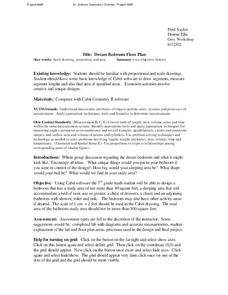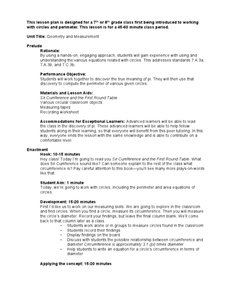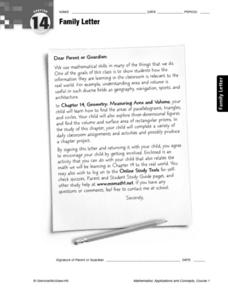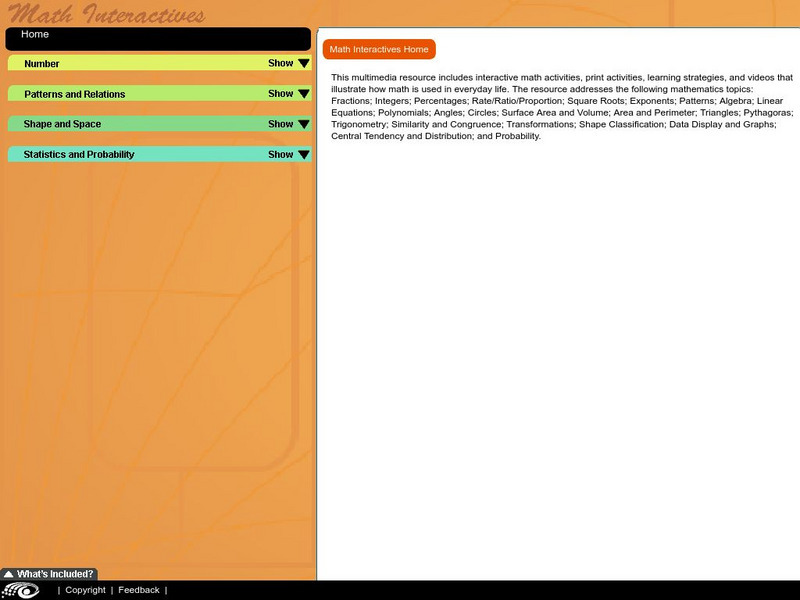EduGAINs
Making Savvy Consumer Choices
It's never too early to learn about grocery budgeting. Middle schoolers delve into the world of consumer math with a lesson plan that focuses on both healthy choices and real-world math applications. Groups work together to form a...
Curated OER
New York Testing Program
In this math review worksheet, students review for their 7th grade exam using a variety of worksheets on different topics. There are 35 problems plus some word problems in the worksheet booklet.
Curated OER
Solve Word Problems with Geometry
In this geometry worksheet, students solve word problems having to do with lines, angles, shapes, area, perimeter, and more. Students complete 57 problems total.
Curated OER
Candy Canes on a Tree
In this algebra worksheet, students calculate how many candy canes and ornaments are on each person's Christmas tree. They are given specific clues to help them calculate their answers. There are 2 questions with an answer key.
Curated OER
Finding the Area Under A Curve with Random Probability
Students explore the concept of area under a curve. In this area under a curve lesson, students find the area under a curve using the Monte Carlo method using random points and probability. Students calculate the area under the same...
Curated OER
Peter's Second String
Fifth graders determine the maximum area and range of areas of a rectangle with a given perimeter. They discuss a word problem involving perimeter and area as a class, investigate the word problem using a piece of string, and in small...
Curated OER
Rep Tiles
Third graders use pattern blocks of one shape at a time to try to create a similar shape. They compare the perimeter of the new figure with the perimeter of the original shape and look for a pattern. Students use the pattern to predict...
Curated OER
Measurement
Seventh graders measure surface area. In this geometry lesson, 7th graders find the surface area of various geometrical shapes. Using a computer program, students compute the area of 2-D and 3-D shapes. Students use...
Curated OER
Dream Bedroom Floor Plan
Students build and apply concepts of geometry. In this geometry lesson, students create a building using proportions and scale drawings. They use Cabri technology to create a virtual drawing first.
Curated OER
Dream Bedroom Floor Plan
Students construct using Cabri software. For this geometry lesson, students convert between units and apply the correct measurements to build objects. They create the room virtually and manipulate the shapes to the desired measurements.
Curated OER
Geometry and Measurement
Students view a right triangle displayed by the teacher. Students measure legs and the interior angles of the triangle. They look for a pattern or relationship between the legs and angles. Students use pegboards and string to create more...
Curated OER
Round The Track
Fourth graders develop problem solving skills while learning to measure an athletic track. The focus upon logic and reasoning is helpful for all types of science and math calculations.
Curated OER
Care Homework #1: Real Numbers
In this care homework worksheet, students add, subtract, multiply and divide numbers with decimals. They solve problems involving mixed numbers. Students find the area and perimeter of triangles and rectangles. This...
Curated OER
Family Activity-- Finding Areas of Triangles
In this math worksheet, students work at home with a family member to identify triangles and find the areas. Students find 3 triangles in tile patterns, wallpaper, paintings or anywhere in the home and answer 6 questions.
Curated OER
Area of Parallelograms
Seventh graders review the process of finding the area of a rectangle and complete a couple of examples as a class. They discuss what a parallelogram is and what the formula would be for finding its area. They listen to an explanation...
Curated OER
ndirect Measurement Technique: Using Trigonometric Ratios
Ninth graders find the height of an object that would be difficult or impossible to measure directly. They construct and use a Clinometer to measure the angle of elevation (or depression). Students create a sketch of the measurement...
Curated OER
Fences and Posts
Fifth graders use Geoboards to demonstrate how shapes can be made by looping the rubber bands over the nails. They make a triangle on their Geoboards. At least one side of the triangle should be either horizontal or vertical. The picture...
Curated OER
Karen's Tiles
Young scholars investigate how perimeter changes as area changes to see the relation between area and perimeter for similar shapes. They then students answer the question if the area of the rectangle increase, does its perimeter have to...
Government of Alberta
Learn Alberta: Math Interactives: Exploring Surface Area, Volume, and Nets
Investigate the concepts of area, volume, 3D shapes, and nets using this interactive Learn Alberta math. The solid shapes focused on this exploration include rectangular and triangular prisms, rectangular and triangular pyramids,...
Calculator Soup
Calculator Soup: Volume Calculator
Use this online calculator to calculate the volume of geometric solids including a capsule, cone, frustum, cube, cylinder, hemisphere, pyramid, rectangular prism, sphere, and spherical cap.



















